Citrus Bearded Dragon Baby Citrus Bearded Dragon Baby Orange
There are eight different bearded dragon species in the wild. The most popular is the Pogona vitticeps and only four out of eight species are kept as pets.
Every type of Bearded Dragon is from Australia but they are all different in appearance.
The most common colors are tan, yellow, olive-green, and red.
Herpetologists mate bearded dragon morphs to produce different patterns and colors. There are now over 20 morphs.
If you are planning on purchasing this pet, and want to know what colors are available, then keep reading…
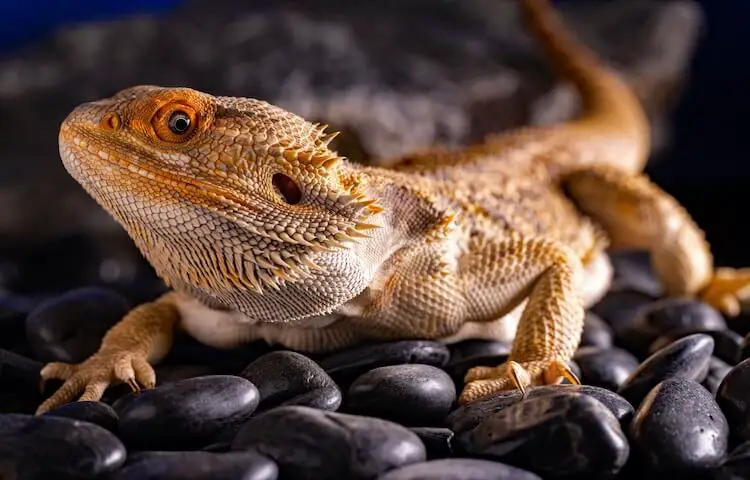
Table of Contents
- Types of Bearded Dragons
- Bearded Dragon Morphs
- A-Z Bearded Dragon Colors List
- Red Bearded Dragon Morphs
- Translucent Bearded Dragon
- White Bearded Dragon
- Black Bearded Dragon Morphs
- Albino Bearded Dragon
- Yellow Bearded Dragon Morphs
- Orange Bearded Dragon
- Leatherback Bearded Dragon
- Paradox Bearded Dragon
- Summary
Types of Bearded Dragons
There are eight different bearded dragons that all belong to the Pogona family (i.e. genus).
All eight are different in size, have unique colors and their own set of behaviors:
- Pogona barbata
- Pogona henrylawsoni
- Pogona microlepidota
- Pogona minor minor
- Pogona minor minima
- Pogona minor mitchelli
- Pogona nullarbor
- Pogona vitticeps
Each species originates from a slightly different habitat, so has its own unique set of behaviors. A good example is the Pogona barbata. They are the only species found in eastern Australia and are much stronger climbers because of the densely wooded areas found in this region.
The most common pet species is the Pogona vitticeps.
This species does better than other species of bearded dragon because of their docile and calm nature.
Every type of bearded dragon originates from Australia – but are from different parts of the island. Depending on where they live on the island influences their preferred habitat.
| Species | Adult Size | Color | Location |
|---|---|---|---|
| Pogona barbata | 24 inches | Gray or red | Eastern Australia |
| Pogona henrylawsoni | 12 inches | Tan or yellow | Western and Central Australia |
| Pogona microlepidota | 4 to 6 inches | Tan or red | Northern Australia |
| Pogona minor minor | 14 to 18 inches | Tan or brown | Western and Central Australia |
| Pogona minor minima | 12 inches | Tan or brown | Houtman Abrolhos Islands |
| Pogona minor mitchelli | 18 inches | Tan or red | Northwestern Australia |
| Pogona nullarbor | 14 inches | Tan or brown | Southern Australia |
| Pogona vitticeps | 24 inches | Yellow or red | Central Australia |
Bearded Dragon Morphs
Morphs are Bearded Dragons that have been selectively bred to create either a specific color, appearance, pattern or combination of all three. Morph breeding is common in many reptiles.
A Bearded Dragon's color, pattern, and scalation aren't due to a single gene, but are caused by a variety of genes interacting together.
Genes are made up of an organism's DNA that contains instructions for development. Genes work together to create the traits. For a bearded dragon morph these traits include the organism's size, color, and behavior.
Many desired traits are recessive which makes them hard to breed.
Some specific morphs require breeding over several generations to create unique colorations or patterns. There are three main types of morph:
- Scalation
- Pattern
- Color
The difficulty in producing a desired color typically correlates with their price – you can see a price list below.
A-Z Bearded Dragon Colors List
Predicting a Bearded Dragon's color and markings can be a challenge.
In addition to genetics, environmental conditions can impact their color – especially with black morphs
They change their color to blend in better with their environment and to thermoregulate. Beardies also display a black beard when they feel threatened.
| Rank | Color | Appearance | Price ($) |
|---|---|---|---|
| 6 | Albino | Red eyes and completely white skin | [n.a.] |
| 5 | Black | Darker skin or black spots because of environmental conditions | [n.a.] |
| 2 | Blue | Translucent | $300 to $400 |
| 4 | Citrus | Yellow with darker orangish red stripes | $100 to $200 |
| 11 | Citrus Tiger | More defined orange stripes than a citrus | $100 to $200 |
| 16 | Green | Olive and green with the standard yellows | $200 to $300 |
| 20 | Lemon Fire | Very bright and vivid yellow | $200 to $300 |
| 10 | Orange | Various shades of orange including burnt brown shades | $100 to $200 |
| 7 | Purple | Purple tint and translucent | $300 to $400 |
| 1 | Red | Various shades of red including brown shades and brighter more vibrant shades | $50 to $150 |
| 19 | Ruby Red | Deep dark red | $200 to $300 |
| 13 | Sandfire | Tan or red with various stripes and bands | $100 to $200 |
| 17 | Sandfire Red | Red with highlights of yellow and orange | $100 to $200 |
| 8 | Silkie | No spikes or scales | $100 to $200 |
| 15 | Snow | Completely white with no markings | $200 to $400 |
| 12 | Sunburst | Yellow with orange highlights | $100 to $200 |
| 18 | Tangerine | Distinctive orange with occasional yellow highlights | $200 to $300 |
| 14 | Translucent | Light yellow to white with a clearish blue stomach | $300 to $400 |
| 3 | White | White with occasional patches of color | $300 to $400 |
| 9 | Yellow | Various shades of yellow including tan | $100 to $200 |
Red Bearded Dragon Morphs
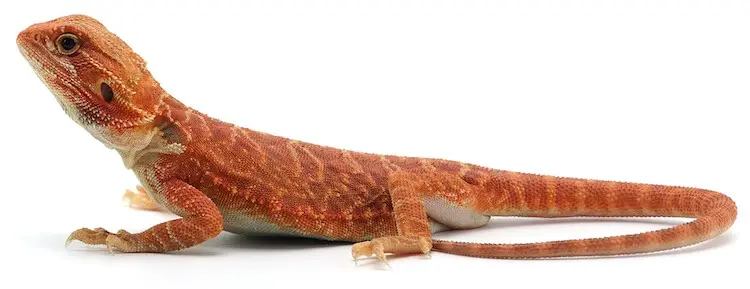
Some wild species have specks and highlights of red. However, entirely red species are morphs that have been bred in captivity. They were first bred after Beardies entered the reptile industry in the 90s.
They can come in a variety of different shades of red. Some are darker with brown shades of red and others are vivid red.
There are also ruby red bearded dragons that are a much darker and deeper red.
Red and ruby red morphs are highly sought after and very expensive when compared to other morphs in this list.
Translucent Bearded Dragon
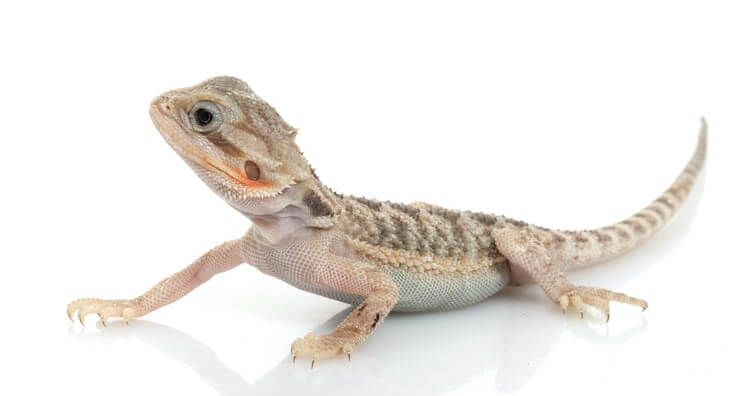
The translucent breed gets its name from its transparent spikes and scales. This morph also has lighter colorations when compared to the others in this list.
They also have very dark black eyes – this is a unique trait. Their eyes typically change between being solid black and yellow several times throughout their lives.
Translucent babies have a clear blue stomach. However their blue color typically fades after a few months as they grow.
Blue and purple bearded dragons are very rare and can only happen when this translucent species retains their color into adulthood.
White Bearded Dragon
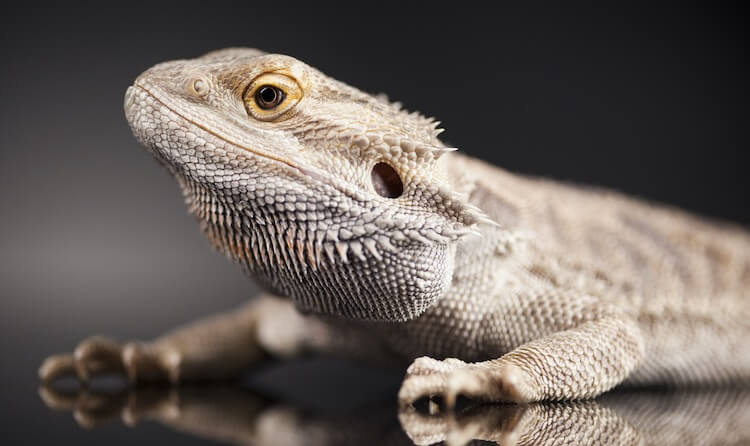
Snow bearded dragons are very rare white morphs that lack pattern, color and sometimes cost $400.
The white bearded dragon's color varies with temperature:
- They are gray in cooler climates.
- They are white in hotter climates.
White morphs (pictured above) result from breeding a snow and a witblit beardie (a patternless morph).
They are similar in appearance to the snow species but have smaller blotches of dark spots.
Black Bearded Dragon Morphs
Some beardies naturally have more pigment in their skin and are darker in appearance. However, completely black bearded dragons are almost unheard of.
This species can appear black because of their environment or aggression.
Reptiles are ectotherms so have to regulate their own body temperature from the environment around them. If they are too cold then they will naturally become darker in color to absorb more heat.
Some will turn their beard black when they are ill, stressed, or feel threatened.
Albino Bearded Dragon
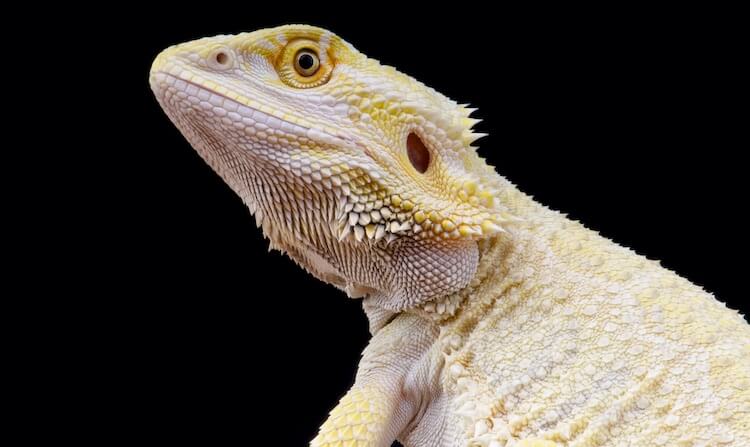
An albino reptile is one that does not produce melanin and has red eyes.
It is possible for albinos to be born naturally. Unfortunately, they do not live past a few weeks old as they cannot properly absorb UVB rays and process calcium effectively.
Most breeders advertising albino morphs for sale are mistaken and really have a leucistic (pictured above), snow bearded, or white bearded dragon
Yellow Bearded Dragon Morphs
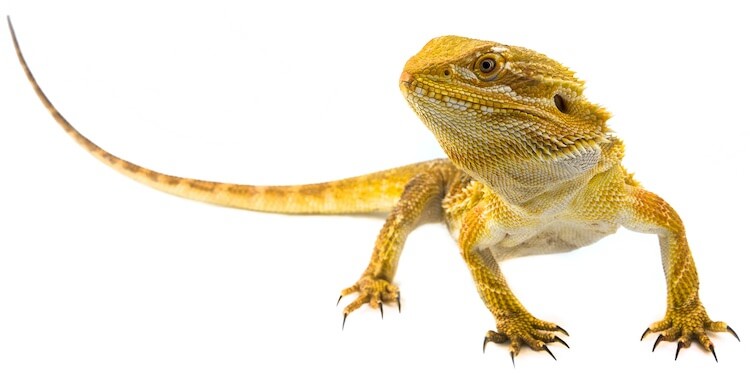
In addition to the standard yellow color there are four other yellow morphs. The amount of yellow and the patterns associated with them can vary greatly among different species:
- Citrus.
- Green.
- Lemon Fire.
- Sandfire Gold.
Citrus species are the most popular yellow morph and have darker orange-red stripes down the center of their back and along the sides of their body. Between their vertical orange stripes they have horizontal gray-blue markings.
As hatchlings, citrus morphs are olive or green in color.
Some citrus hatchlings retain their green color into adulthood and are called green bearded dragons.
Lemon fire bearded dragons are not as popular as citrus species. They have a very bright and vivid yellow color that is unlike any other morph. Sandfire gold beardies have a tan-like appearance with stripes across their bodies.
Orange Bearded Dragon
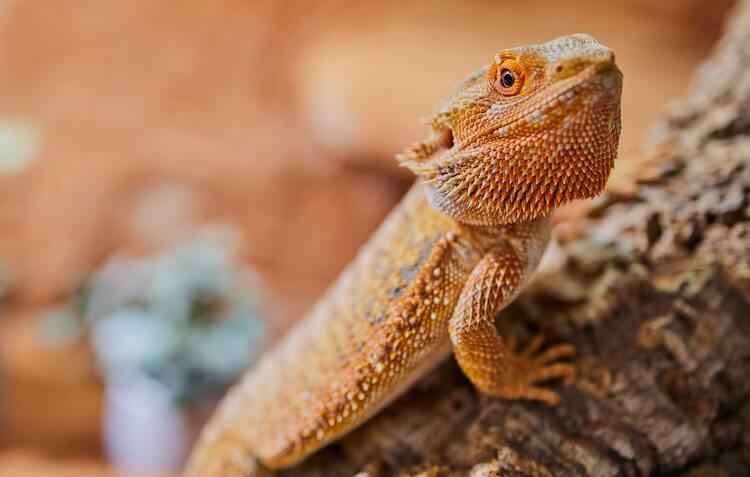
Yellow and red bearded dragon morphs are bred to produce orange morphs.
These combinations are some of the brightest and most striking morphs in captivity.
The four most common oranges morphs are:
- Orange.
- Tangerine.
- Sandfire.
- Sunburst.
Orange beardies are solid orange and lack the vivid colors found in the Tangerine, Sandfire and Sunburst morphs. Tangerine morphs have a very distinctive bright orange body with yellow highlights. Some have a neon orange appearance.
Sandfire red morphs have a red body color with highlights of yellow and orange.
Leatherback Bearded Dragon
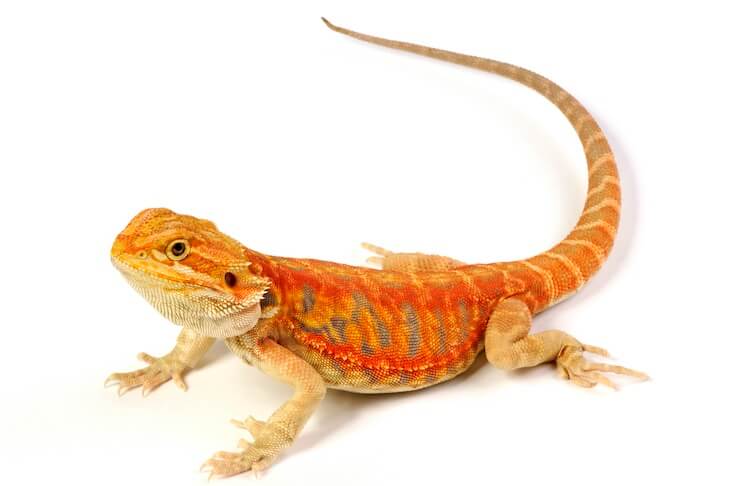
Leatherbacks are a great example of scalation morphs.
The amount, size, and position of a bearded dragon's scales and spikes can vary greatly.
There are several scalation mutations that are specifically bred by enthusiasts, the most popular are the Leatherback, Silkie, Microscale and Dunner.
Leatherbacks have smooth scales and are bred from heterozygous genes. They do not have any spikes along their backs or limbs. The only spikes they have are along both sides of their body.
Silkies are another type of scalation morph bred from homozygous recessive genes.
They are unlike any other morph because they completely lack spikes and scales found on all other bearded dragon species.
They get their name from their vibrantly colored silkie smooth skin. Breeders insist this morph is one of the most difficult to care for in captivity because of their lack of scales. They also have trouble regulating UV rays because of their unusual skin. There is a movement to remove silkies from the industry since they struggle in captivity.
The microscale beardie is the third scalation morph.
Microscales only have spikes on their head and beard. These spikes are much smaller than typical bearded dragon's spikes. They are very rare and expensive.
Finally, Dunner bearded dragons have scales that point towards the sides – instead of running from head to tail. Dunners also have vertical bands of color instead of the typical horizontal bands. As well as being a scalation morph the Dunner is also a pattern morph.
Paradox Bearded Dragon
A typical bearded dragon has a pattern of banded colors along their back and tail.
However, the Paradox morph is bred for their distinct pattern. The Tiger Stripe and Witblit are also selectively bred for their unique patterns:
- Paradox's patterns are completely unique and have a series of irregular patches of color.
- Tiger stripes have dark horizontal orange and gray stripes along their back.
- Witblits are bred because they lack stripes and bands.
Reptile enthusiasts love pattern morphs because of their distinct and unusual appearance.
Summary
There are eight different types of bearded dragons in the Pogona family.
The Pogona vitticeps is one of the most popular pet reptiles due to its calm and docile nature.
Bearded dragon morphs have been selectively bred for over two decades with new colors, patterns, and scalations appearing each year.
There are now over 20 different morphs in captivity.
Unfortunately some morphs (e.g. Albino and Silkies) have many health issues so it is important to do your research before purchasing some of the rarer species.
Let us know your favorite type of morph in the comments below.
Citrus Bearded Dragon Baby Citrus Bearded Dragon Baby Orange
Source: https://www.everythingreptiles.com/types-of-bearded-dragons/
0 Response to "Citrus Bearded Dragon Baby Citrus Bearded Dragon Baby Orange"
Post a Comment